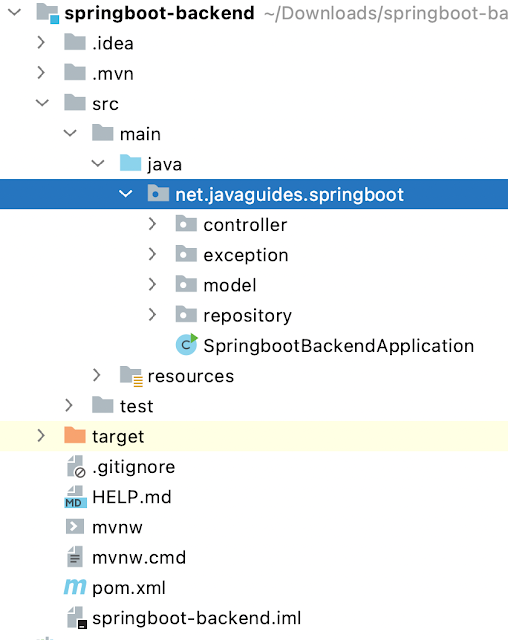YouTube Video
1. Create a Spring boot application
Spring Boot provides a web tool called Spring Initializer to bootstrap an application quickly. Just go to https://start.spring.io/ and generate a new spring boot project.
Use the below details in the Spring boot creation:
Project Name: springboot-backend
Project Type: Maven
Choose dependencies: Spring Web, Lombok, Spring Data JPA, and MySQL Driver
Package name: net.javaguides.springboot
Packaging: Jar
Download Spring Boot project as a zip file, unzip it, and import it into IntelliJ IDEA.
Here is the pom.xml file for your reference:
<?xml version="1.0" encoding="UTF-8"?>
<project xmlns="http://maven.apache.org/POM/4.0.0" xmlns:xsi="http://www.w3.org/2001/XMLSchema-instance"
xsi:schemaLocation="http://maven.apache.org/POM/4.0.0 https://maven.apache.org/xsd/maven-4.0.0.xsd">
<modelVersion>4.0.0</modelVersion>
<parent>
<groupId>org.springframework.boot</groupId>
<artifactId>spring-boot-starter-parent</artifactId>
<version>3.0.4</version>
<relativePath/> <!-- lookup parent from repository -->
</parent>
<groupId>net.javaguides</groupId>
<artifactId>springboot-backend</artifactId>
<version>0.0.1-SNAPSHOT</version>
<name>springboot-backend</name>
<description>Demo project for Spring Boot REST APIs</description>
<properties>
<java.version>11</java.version>
</properties>
<dependencies>
<dependency>
<groupId>org.springframework.boot</groupId>
<artifactId>spring-boot-starter-data-jpa</artifactId>
</dependency>
<dependency>
<groupId>org.springframework.boot</groupId>
<artifactId>spring-boot-starter-web</artifactId>
</dependency>
<dependency>
<groupId>com.mysql</groupId>
<artifactId>mysql-connector-j</artifactId>
<scope>runtime</scope>
</dependency>
<dependency>
<groupId>org.projectlombok</groupId>
<artifactId>lombok</artifactId>
<optional>true</optional>
</dependency>
<dependency>
<groupId>org.springframework.boot</groupId>
<artifactId>spring-boot-starter-test</artifactId>
<scope>test</scope>
</dependency>
</dependencies>
<build>
<plugins>
<plugin>
<groupId>org.springframework.boot</groupId>
<artifactId>spring-boot-maven-plugin</artifactId>
<configuration>
<excludes>
<exclude>
<groupId>org.projectlombok</groupId>
<artifactId>lombok</artifactId>
</exclude>
</excludes>
</configuration>
</plugin>
</plugins>
</build>
</project>2. Create Project or Packaging Structure
3. Configure MySQL Database
spring.datasource.url=jdbc:mysql://localhost:3306/ems?useSSL=false
spring.datasource.username=root
spring.datasource.password=Mysql@123
spring.jpa.properties.hibernate.dialect = org.hibernate.dialect.MySQLDialect
spring.jpa.hibernate.ddl-auto = update4. Create JPA Entity
package net.javaguides.springboot.model;
import lombok.AllArgsConstructor;
import lombok.Getter;
import lombok.NoArgsConstructor;
import lombok.Setter;
import jakarta.persistence.*;
@Getter
@Setter
@NoArgsConstructor
@AllArgsConstructor
@Entity
@Table(name = "employees")
public class Employee {
@Id
@GeneratedValue(strategy = GenerationType.IDENTITY)
private long id;
@Column(name = "first_name")
private String firstName;
@Column(name = "last_name")
private String lastName;
@Column(name = "email_id")
private String emailId;
}5. Create Spring Data JPA Repository
package net.javaguides.springboot.repository;
import net.javaguides.springboot.model.Employee;
import org.springframework.data.jpa.repository.JpaRepository;
import org.springframework.stereotype.Repository;
public interface EmployeeRepository extends JpaRepository<Employee, Long> {
// all crud database methods
}6. Create ResourceNotFoundException Custom Exception
Go to an exception package, create a class named ResourceNotFoundException and add the following content to it:
package net.javaguides.springboot.exception;
import org.springframework.http.HttpStatus;
import org.springframework.web.bind.annotation.ResponseStatus;
@ResponseStatus(value = HttpStatus.NOT_FOUND)
public class ResourceNotFoundException extends RuntimeException{
public ResourceNotFoundException(String message){
super(message);
}
}7. Creating Spring Boot CRUD REST APIs
Go to controller package, create a class named EmployeeController and add the following content to it:
package net.javaguides.springboot.controller;
import net.javaguides.springboot.exception.ResourceNotFoundException;
import net.javaguides.springboot.model.Employee;
import net.javaguides.springboot.repository.EmployeeRepository;
import org.springframework.beans.factory.annotation.Autowired;
import org.springframework.http.HttpStatus;
import org.springframework.http.ResponseEntity;
import org.springframework.web.bind.annotation.*;
import java.util.List;
@CrossOrigin("*")
@RestController
@RequestMapping("/api/v1/employees")
public class EmployeeController {
@Autowired
private EmployeeRepository employeeRepository;
@GetMapping
public List<Employee> getAllEmployees(){
return employeeRepository.findAll();
}
// build create employee REST API
@PostMapping
public Employee createEmployee(@RequestBody Employee employee) {
return employeeRepository.save(employee);
}
// build get employee by id REST API
@GetMapping("{id}")
public ResponseEntity<Employee> getEmployeeById(@PathVariable long id){
Employee employee = employeeRepository.findById(id)
.orElseThrow(() -> new ResourceNotFoundException("Employee not exist with id:" + id));
return ResponseEntity.ok(employee);
}
// build update employee REST API
@PutMapping("{id}")
public ResponseEntity<Employee> updateEmployee(@PathVariable long id,@RequestBody Employee employeeDetails) {
Employee updateEmployee = employeeRepository.findById(id)
.orElseThrow(() -> new ResourceNotFoundException("Employee not exist with id: " + id));
updateEmployee.setFirstName(employeeDetails.getFirstName());
updateEmployee.setLastName(employeeDetails.getLastName());
updateEmployee.setEmailId(employeeDetails.getEmailId());
employeeRepository.save(updateEmployee);
return ResponseEntity.ok(updateEmployee);
}
// build delete employee REST API
@DeleteMapping("{id}")
public ResponseEntity<HttpStatus> deleteEmployee(@PathVariable long id){
Employee employee = employeeRepository.findById(id)
.orElseThrow(() -> new ResourceNotFoundException("Employee not exist with id: " + id));
employeeRepository.delete(employee);
return new ResponseEntity<>(HttpStatus.NO_CONTENT);
}
}
@GetMapping
public List<Employee> getAllEmployees(){
return employeeRepository.findAll();
}Create Employee REST API:
// build create employee REST API
@PostMapping
public Employee createEmployee(@RequestBody Employee employee) {
return employeeRepository.save(employee);
}Get Employee by Id REST API:
// build get employee by id REST API
@GetMapping("{id}")
public ResponseEntity<Employee> getEmployeeById(@PathVariable long id){
Employee employee = employeeRepository.findById(id)
.orElseThrow(() -> new ResourceNotFoundException("Employee not exist with id:" + id));
return ResponseEntity.ok(employee);
}Update Employee REST API:
// build update employee REST API
@PutMapping("{id}")
public ResponseEntity<Employee> updateEmployee(@PathVariable long id,@RequestBody Employee employeeDetails) {
Employee updateEmployee = employeeRepository.findById(id)
.orElseThrow(() -> new ResourceNotFoundException("Employee not exist with id: " + id));
updateEmployee.setFirstName(employeeDetails.getFirstName());
updateEmployee.setLastName(employeeDetails.getLastName());
updateEmployee.setEmailId(employeeDetails.getEmailId());
employeeRepository.save(updateEmployee);
return ResponseEntity.ok(updateEmployee);
}Delete Employee REST API:
// build delete employee REST API
@DeleteMapping("{id}")
public ResponseEntity<HttpStatus> deleteEmployee(@PathVariable long id){
Employee employee = employeeRepository.findById(id)
.orElseThrow(() -> new ResourceNotFoundException("Employee not exist with id: " + id));
employeeRepository.delete(employee);
return new ResponseEntity<>(HttpStatus.NO_CONTENT);
}8. Running the Application
$ mvn spring-boot:run







Comments
Post a Comment
Leave Comment